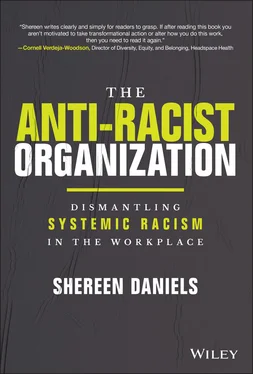Have the ability to put your head above the parapet, to ask tough questions of yourself and others, and be prepared to listen, really listen, and have your views, beliefs and perspectives of the world challenged
Are willing to work hard to resist feeling superior, of being the saviour, of taking action geared towards what looks good rather than what makes a difference and when times get tough, doesn't resort to “can't do right for doing wrong” thinking.
An End to Business Cases?
The business case for dismantling systemic racism is not one of economics. Many people have suggested I talk more about the financial benefits that come with addressing this, yet I don't need to, partly because there are plenty of studies and articles totaling how much exclusion costs our economies, but more importantly because I'm not about to build a business case to address inequality or basic human rights.
Instead, this book is an opportunity for those who want to hear from someone who has publicly and privately committed, day in and day out, to doing the work to unlock thousands of global conversations about race. Who has been doing the work with brands and organizations all over the world who decided they could no longer do nothing. Partnering with leaders who wanted to build deeper partnerships with their colleagues, customers and communities who wanted to evolve their cultures to become more anti‐racist, equitable and kind and who every day practice pushing past their discomfort and defensiveness about racism to understand the interconnectedness of all of our experiences, recognising it's impossible to separate what happens in society from what plays out within the four walls of their companies. And that the root causes of what negatively impacts one community damages us all.
This book is about recognising the cost of silence, of looking the other way, of doing little to nothing about an issue that was raised to the forefront of society (again) by the murder of George Floyd on 25 May 2020, which we all saw on our television screens and mobile phones.
This book is about acknowledging that your colleagues are human beings first, and that prioritising the needs of Black people – whether they are friends, family members, peers, colleagues, customers, suppliers, partners or community members – is nothing to be afraid or ashamed of.
This book is about understanding what it takes to be an anti‐racist organization and genuinely dismantle systemic racism within your workplace.
The work is done when we no longer need to use the word ‘anti‐racist’.
1 Entering the Global Race for Racial Equality
The company was not as far ahead as we should have been .
I wasn't as far ahead as I should be .
I felt exposed as a leader, and as an organization because we didn't have our shit together, and the issues of systemic racism affect our colleagues. Therefore it affected me. And I felt it should affect us all .
Client, 2020
Can you remember a time in your career where you thought there would be so many conversations happening about race? And did you ever, for a second, foresee that you would have to spearhead some of these conversations and lead those actions?
Times have truly changed, yet not everyone has bought into the evolved expectation of what it takes to be a responsible and sustainable company.
When the murder of George Floyd occurred, the resulting global protests were on a scale we'd never seen before. George Floyd wasn't the first and we have a way to go before we can confidently say he is the last, but in that moment of time, everything in society changed, and organizations were not exempt.
What are we doing to address this? Are we doing enough? I don't even know where to begin with this .
Chief Executive Officer, 2020
‘Stakeholder capitalism' has increasingly become a common way to describe the expectation that companies provide long‐term value creation. Going beyond a binary focus on shareholder returns, it's now encompassing customers, suppliers, colleagues, investors, communities and others who have a stake in the business, generating value for all stakeholders, not just for shareholders.

Figure 1.1Stakeholder capitalism spectrum.
Source: © HR rewired
Where does your organization sit?
It is not as simple as the assumption that you are either for or against stakeholder capitalism, that you are either a capitalist or an anti‐capitalist. It's more nuanced than that. Instead, think of it as a spectrum. At one end of the scale, customers, employees and communities are merely tools to maximise profits for the benefit of shareholders. At the opposite end, companies exist for the benefit of the public good: purpose beyond profit, and ensuring the needs of as many stakeholders as possible are met.
You have a choice in deciding where you fit on that spectrum and much of that will be driven by your values, your mission and how you want to be perceived in your industry and by the world at large.
Stakeholder capitalism is not a new term – in fact, it goes back to the Great Depression – but it has a new relevance. Dozens of the world's largest companies, representing trillions of pounds in market capitalization, have pledged to use a uniform set of “Stakeholder Capitalism Metrics” as part of the mainstream disclosures. This was announced 26 January 2021 by the World Economic Forum and its International Business Council when leaders from governments and corporates convened for a virtual version of the annual Davos conference. These commitments were seen as an opportunity to address the Sustainable Development Goals (SDGs; also known as Global Goals), adopted by the United Nations in 2015 as a universal call to action to end poverty, protect the planet and ensure that by 2030 all people would enjoy peace and prosperity.
Regardless of whether you are a fan or a critic of environmental, social and governance (ESG) standards and to what extent you believe they are a legitimate tool to drive more sustainable and responsible business practices, it isn't possible to operate in today's and tomorrow's environment without an awareness of how your company operates against these standards.
The leadership teams with an edge on adjusting their approach to delivering against new expectations in tackling racism are those who are using this movement to redefine their values and purpose to ensure there is an alignment between their words and actions. On the flip side, stakeholders are continually looking for indicators that reinforce commitments.
Stakeholder capitalism isn't without its critics, of course. It's easy to claim you are a people‐centered company and give the illusion of caring about your stakeholders, even if your day‐to‐day culture and practices tell a different story.
The reality is that in the minds of some leaders, maximising profit means avoiding anything controversial that may damage public perception, which in turn hits the bottom line.
What is controversial?
Racism.
Whether we care to admit it – irrespective of how much quantitative and qualitative data exists to show that modern society still has an issue with racism, that everyday human rights are being violated and often recorded on mobile phones and talked about in real time on social media – for some, genuinely addressing the issue is too risky.
Silence on issues relating to racism was the smart and safe play. Until silence itself become controversial.
We saw a plethora of companies change their social media feeds to black, and incorporate the latest trending Black Lives Matter hashtag to ensure they were seen to be acting in solidarity with the Black community. Whilst the world was distracted, there wasn't an initial focus on the substance of these commitments. The hype was real, and well‐known brands swiftly committed to doubling or tripling the number of Black hires in senior positions (conveniently using percentage language, which doesn't sound nearly as great when you realise that doubling the percentage of Black managers by 50% actually means hiring one more Black person if there's only currently one Black person on the board), and propelled ever‐increasing budgets to social justice funds like auctioneers at Homes Under the Hammer . Anecdotal stories abound of companies committing millions in social justice funding, only to have it revealed that a year later barely a penny had been spent. It quickly became apparent that a lot of organizations opted for style over substance.
Читать дальше













